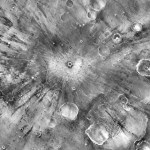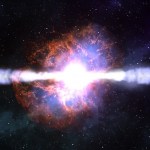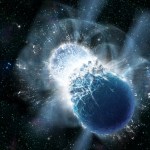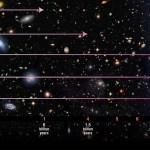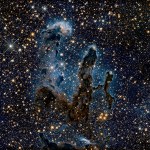Astronomy
"Although we were initially quite skeptical that this planet could exist, as we continued to investigate its orbit and what it would mean for the outer solar system, we become increasingly convinced that it is out there." -Konstantin Batygin
Last year, scientists Konstantin Batygin and Mike Brown made a huge splash when they announced that the Solar System likely contained a super-Earth-sized object beyond the orbit of Neptune. They dubbed the world ‘Planet Nine,’ and claimed that it was responsible for the orbits of the longest-period Trans-Neptunian Objects ever discovered. The fact…
"It shows you exactly how a star is formed; nothing else can be so pretty! A cluster of vapor, the cream of the milky way, a sort of celestial cheese, churned into light." -Benjamin Disraeli
From here on Earth, most of the stars we see in the night sky are ancient, having departed from the star-forming regions and open clusters that spawned them many millions or even billions of years ago. But there are still new stars forming in the Milky Way, and the vast majority of these star-forming regions are located in the galactic plane itself.
The Omega nebula, known also as Messier 17, is an…
“There is no such thing as perpetual tranquillity of mind while we live here; because life itself is but motion, and can never be without desire, nor without fear, no more than without sense.” -Thomas Hobbes
It’s hard to believe, but despite being at rest here on the surface of Earth, we’re actually hurtling through the Universe in a variety of impressive ways. The Earth spins on its axis, giving someone at the equator a speed of some 1700 km/hr. Yet at even faster speeds, the Earth orbits the Sun, the Sun moves through the Milky Way, and there’s a great cosmic motion that applied to the…
"Not all chemicals are bad. Without chemicals such as hydrogen and oxygen, for example, there would be no way to make water, a vital ingredient in beer." -Dave Barry
When we break out the big guns -- space telescopes like Hubble or James Webb -- we can see the Universe as it was billions of years ago, if we look for long enough. From the first moment that the Universe forms stars and galaxies, so long as that light has a path to our eyes, humanity can view it with the right equipment. This record-breaking approach has brought us in contact with galaxies from as early as when the Universe was…
"This would be like an F8 tornado sweeping across the surface. These are winds on Mars that will never be seen again unless [there is] another impact." -Peter Schultz
When you examine craters on the surfaces of worlds across the solar system, you find that there are rays emanating outward, containing a mix of ejecta from the impactor and the surface itself. But there’s a limit to how far those rays go, and that’s normally dependent on the size of the crater. In a few instances on Mars, however, those rays go much, much farther than physics would indicate.
A detailed, infrared view of a…
"Billions of years from now our sun, then a distended red giant star, will have reduced Earth to a charred cinder." -Carl Sagan
“Bigger mass makes a bigger star,” you might be inclined to say. The smallest stars in size should be small because they have the least amount of material in them, while the largest ones of all are the largest because they’ve got the most material to make stars out of. And that’s a tempting explanation, but it doesn’t account for either the smallest stars or the largest ones in the Universe.
The (modern) Morgan–Keenan spectral classification system, with the…
"People who work every day are kind of scared of things they don't understand." -Young Jeezy
From Mercury out to Neptune, most of the worlds in the Solar System have moons, with a hitherto discovered population of around 200 known ones. Yet despite all of it, we don’t know of a single instance of a moon that has its own natural satellite: a moon with a moon of its own. But that doesn’t mean it couldn’t exist!
The major moons in our Solar System could contain some objects with candidates for potentially having orbiting moons of their own. If many of these moons were situated differently,…
"The black holes collide in complete darkness. None of the energy exploding from the collision comes out as light. No telescope will ever see the event." -Janna Levin
Whenever there’s a catastrophic, cataclysmic event in space, there’s almost always a tremendous release of energy that accompanies it. A supernova emits light; a neutron star merger emits gamma rays; a quasar emits radio waves; merging black holes emit gravitational waves. But if there’s any sort of matter present outside the event horizons of these black holes, they have the potential to emit electromagnetic radiation, or light…
“No matter what technique you use, you should get the same value for the expansion rate of the universe today.” -Ben Hoscheit
When you think of the Universe on the largest scales, you likely think of galaxies grouped and clustered together in huge, massive collections, separated by enormous cosmic voids. But there’s another kind of cluster-and-void out there: a very large volume of space that has its own galaxies, clusters and voids, but is simply higher or lower in density than average.
The construction of the cosmic distance ladder involves going from our Solar System to the stars to…
"Black holes are the seductive dragons of the universe, outwardly quiescent yet violent at the heart, uncanny, hostile, primeval, emitting a negative radiance that draws all toward them, gobbling up all who come too close…these strange galactic monsters, for whom creation is destruction, death life, chaos order." -Robert Coover
For the third time since it began taking data, the LIGO collaboration discovered direct evidence for merging black holes in the Universe. There's an incredible amount we've learned about black holes and where they're located, however, and very little of it comes from…
“Unless one says goodbye to what one loves, and unless one travels to completely new territories, one can expect merely a long wearing away of oneself and an eventual extinction.” -Jean Dubuffet
In the far future, all the galaxies within our Local Group will merge together, with enough gas and stellar material to form trillions upon trillions of new stars. But the amount of fuel is finite, and gravitational interactions are chaotic. At some point, the star forming material contained in our galaxy will come to an end, while more and more stars and stellar remnants are ejected from the galaxy.…
"Where we're going, we won't need eyes to see." -Sam Neill, Event Horizon
Are event horizons real? With data taken from around a dozen observatories earlier this year, simultaneously, the Event Horizon Telescope is poised to put together the first-ever direct image of the black hole at the center of our galaxy Sagittarius A*. If event horizons are real, this data should be able to create the first-ever image of it, proving that nothing escapes from inside a black hole once you’ve been swallowed.
Five different simulations in general relativity, using a magnetohydrodynamic model of the black…
"If you're puzzled by what dark energy is, you're in good company." -Saul Perlmutter
We normally assume that the fundamental constants of the Universe are actually constant, but they don’t have to be that way. They could vary in space, in time, or with the energy density of the Universe, in principle. Before believing in such an extraordinary claim, however, you’d need some remarkable evidence. It’s arguable that exactly that sort of evidence is emerging: from the tensions in the expansion rate of the Universe.
Three different types of measurements, distant stars and galaxies, the large…
"N6946-BH1 is the only likely failed supernova that we found in the first seven years of our survey. During this period, six normal supernovae have occurred within the galaxies we've been monitoring, suggesting that 10 to 30 percent of massive stars die as failed supernovae." -Scott Adams
Everyone knows the recipe for a black hole: create a massive enough star, allow it to burn through the fuel it its core, and wait. After enough time, the core will collapse, creating a type II supernova and a runaway fusion reaction. The outer layers explode while the core implodes, leaving behind a black…
"The Edge... there is no honest way to explain it because the only people who really know where it is are the ones who have gone over." -Hunter S. Thompson
When we look at the nearby Universe, it looks a lot like we, ourselves, appear. Nearby galaxies are similar in structure to our own; the stars inside them have the same properties, masses, ages and distributions as our own. But as we look to greater and greater cosmic distances, we find that more distant galaxies appear younger, bluer, smaller, and less evolved. If we go back beyond a certain point, there are no more galaxies at all.…
"First Rate People hire first rate people. Second rate people hire third rate people." -Hermann Weyl
So, here we are, encountering one another on the internet. There’s a really good chance that this is because you have some interest in space, science, astronomy, astrophysics, or some related area. Although I am an astrophysicist with a Ph,D. in theoretical physics, my focus over the past decade or so has been on education and public outreach: science communication.
As we're exploring more and more of the Universe, education and outreach becomes more vital than ever if our society wants to be…
"As far as I can tell, every telescope that can look at it right now is looking at it right now." -Matt Muterspaugh
Earlier this decade, the Kepler mission became the most successful planet-finding endeavor of all time, turning up thousands of new worlds by measuring the transit data of some 150,000 stars. When planets passed in front of their parent star, they blocked a tiny fraction of their light, leaving behind an imprint of a periodic dimming signal. But one star dims differently from all the others.
Different steps in the Kepler time series data that show the periodic and aperiodic…
"When a massive star explodes at the end of its life, the explosion dispenses different elements-helium, carbon, oxygen, iron, nickel-across the universe, scattering stardust. That stardust now makes up the planets, including ours." -Michelle Cuevas
Every once in a while, a new light appears somewhere in the night sky: the result of a massive star reaching the end of its life. From many millions of light years away, the brilliance of a supernova shines across the cosmos. Just a few days ago, a new light was discovered in a galaxy only 22 million light years away, making it the closest…
"The origin and evolution of life are connected in the most intimate way with the origin and evolution of the stars." -Carl Sagan
The Crab Nebula is one of the most interesting and compelling objects in the entire night sky. In the year 1054, a supernova went off in the constellation of Taurus, where it became brighter than anything other than the Sun and Moon in the sky. Some 700 years later, astronomers discovered the remnant of that supernova: the Crab Nebula.
An optical composite/mosaic of the Crab Nebula as taken with the Hubble Space Telescope. The different colors correspond to…
"When we have found how the nucleus of atoms is built up we shall have found the greatest secret of all — except life." -Ernest Rutherford
What does the future of astrophysics look like? Have we already made all of the fundamental discoveries we’re going to make? Is the rest just categorization of objects, identification of more examples of what’s already known, and minor refinements of the knowledge we already have? Or are there fundamental discoveries still to come, just waiting for us to reveal them?
The four possible fates of our Universe into the future; the last one appears to be the…




